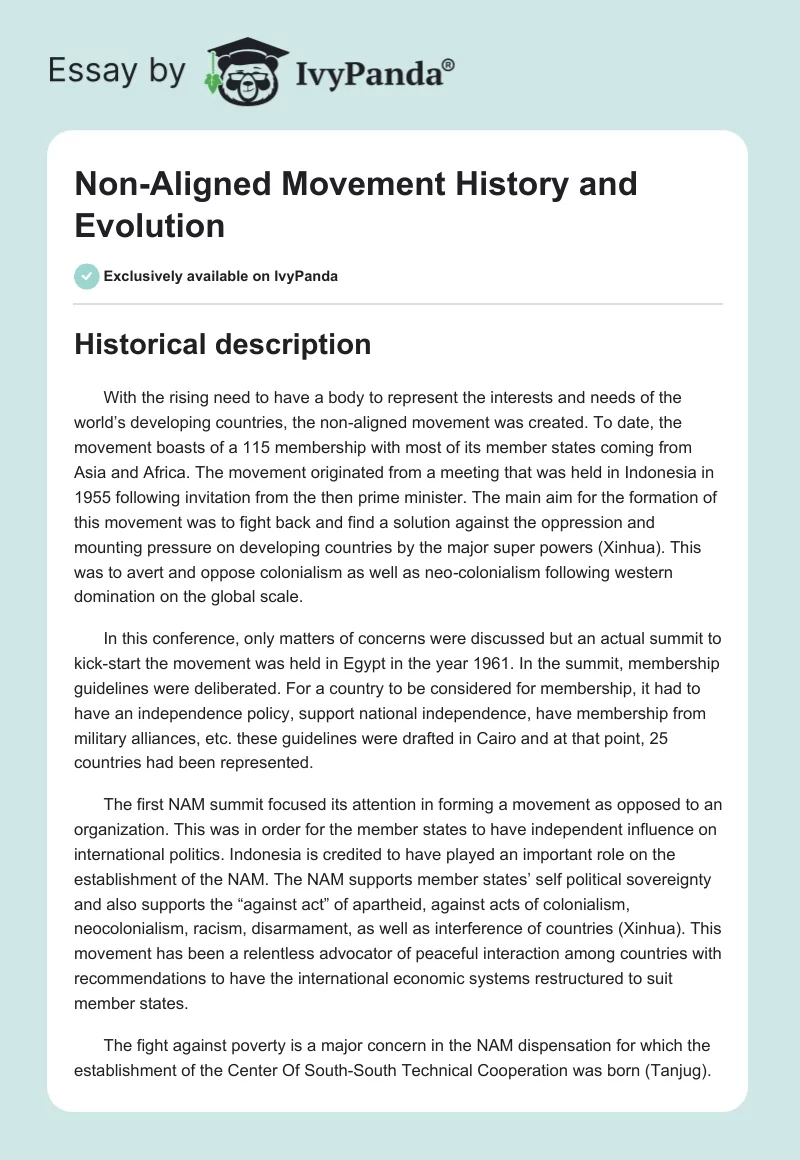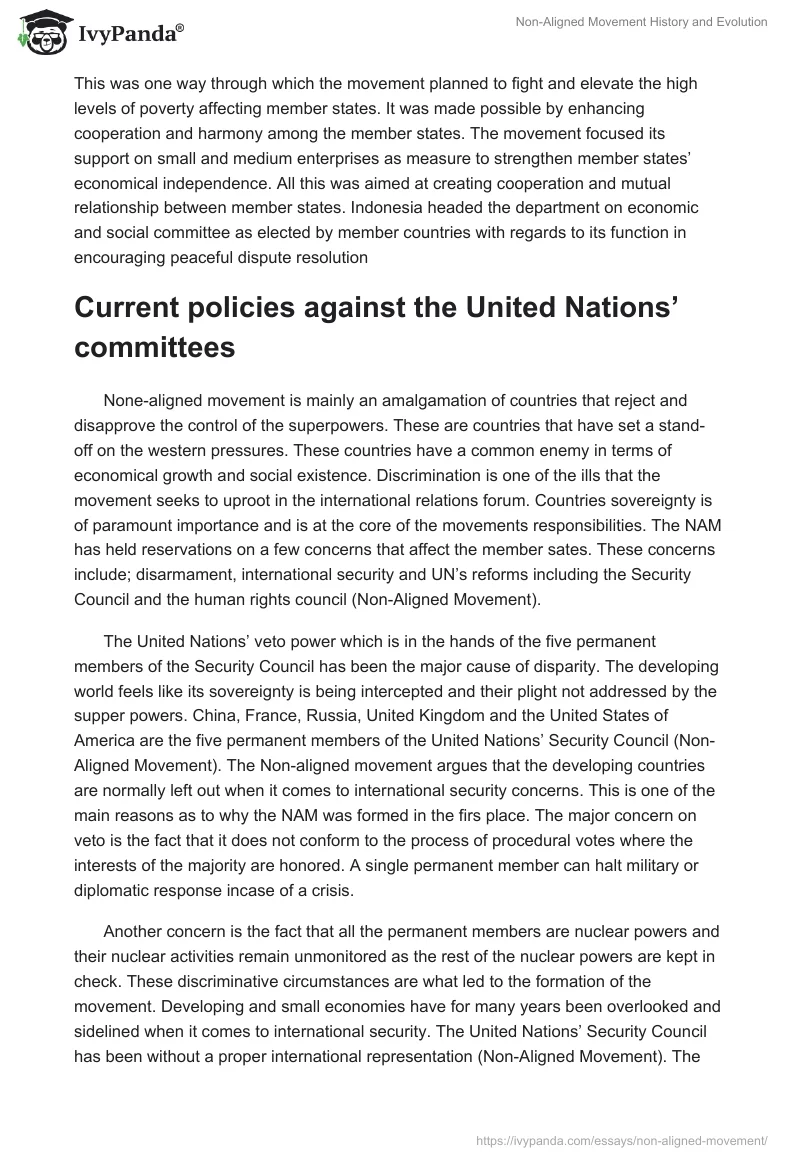Historical description
With the rising need to have a body to represent the interests and needs of the world’s developing countries, the non-aligned movement was created. To date, the movement boasts of a 115 membership with most of its member states coming from Asia and Africa. The movement originated from a meeting that was held in Indonesia in 1955 following invitation from the then prime minister. The main aim for the formation of this movement was to fight back and find a solution against the oppression and mounting pressure on developing countries by the major super powers (Xinhua). This was to avert and oppose colonialism as well as neo–colonialism following western domination on the global scale.
In this conference, only matters of concerns were discussed but an actual summit to kick-start the movement was held in Egypt in the year 1961. In the summit, membership guidelines were deliberated. For a country to be considered for membership, it had to have an independence policy, support national independence, have membership from military alliances, etc. these guidelines were drafted in Cairo and at that point, 25 countries had been represented.
The first NAM summit focused its attention in forming a movement as opposed to an organization. This was in order for the member states to have independent influence on international politics. Indonesia is credited to have played an important role on the establishment of the NAM. The NAM supports member states’ self political sovereignty and also supports the “against act” of apartheid, against acts of colonialism, neocolonialism, racism, disarmament, as well as interference of countries (Xinhua). This movement has been a relentless advocator of peaceful interaction among countries with recommendations to have the international economic systems restructured to suit member states.
The fight against poverty is a major concern in the NAM dispensation for which the establishment of the Center Of South-South Technical Cooperation was born (Tanjug). This was one way through which the movement planned to fight and elevate the high levels of poverty affecting member states. It was made possible by enhancing cooperation and harmony among the member states. The movement focused its support on small and medium enterprises as measure to strengthen member states’ economical independence. All this was aimed at creating cooperation and mutual relationship between member states. Indonesia headed the department on economic and social committee as elected by member countries with regards to its function in encouraging peaceful dispute resolution
Current policies against the United Nations’ committees
None-aligned movement is mainly an amalgamation of countries that reject and disapprove the control of the superpowers. These are countries that have set a stand-off on the western pressures. These countries have a common enemy in terms of economical growth and social existence. Discrimination is one of the ills that the movement seeks to uproot in the international relations forum. Countries sovereignty is of paramount importance and is at the core of the movements responsibilities. The NAM has held reservations on a few concerns that affect the member sates. These concerns include; disarmament, international security and UN’s reforms including the Security Council and the human rights council (Non-Aligned Movement).
The United Nations’ veto power which is in the hands of the five permanent members of the Security Council has been the major cause of disparity. The developing world feels like its sovereignty is being intercepted and their plight not addressed by the supper powers. China, France, Russia, United Kingdom and the United States of America are the five permanent members of the United Nations’ Security Council (Non-Aligned Movement). The Non-aligned movement argues that the developing countries are normally left out when it comes to international security concerns. This is one of the main reasons as to why the NAM was formed in the firs place. The major concern on veto is the fact that it does not conform to the process of procedural votes where the interests of the majority are honored. A single permanent member can halt military or diplomatic response incase of a crisis.
Another concern is the fact that all the permanent members are nuclear powers and their nuclear activities remain unmonitored as the rest of the nuclear powers are kept in check. These discriminative circumstances are what led to the formation of the movement. Developing and small economies have for many years been overlooked and sidelined when it comes to international security. The United Nations’ Security Council has been without a proper international representation (Non-Aligned Movement). The developing countries by this felt like they are being taken for granted as far as international policies are concerned. The formation of the Non-aligned movement was influenced largely by the desire to have the voices of the member states heard as well.
The super powers are running against each other to reinforce influence on the third world countries. These countries are left out from actively participating in international Security Council decisions leaving only the five permanent members of the council to decide on behalf of the world. Asked to expand the number of members to create a democratic security council, the council is reluctant to do so. It is for reasons such as these that the world feels that the United Nations’ course is to protect the interests of the founder member states (Nayan). This shows that the cooperation accorded to the UN’s Security Council by developing and non-developed countries is unfruitful and all in vain. The council derides the opinion of smaller economies thereby undermining democracy and invading other nations’ privacy in the name of international security. This has been cited as the modern time colonial rule where the nuclear super powers are rushing against each other to gain control over the world in as many countries as they can.
The administration of the non-aligned movement is democratic and fair. Unlike in the United Nations’ administration, there is no permanent secretariat averting the possibility of one leader country (Johnson). The system involves rotation in the position of chair and all the countries have equal chances to chair the movement. Global decisions are all inclusive regardless of a country’s size or influence. The United Nations’ capability in preventing crises and conflict has been receiving a lot of critism in the recent past. The United Nations watched the killing of innocent civilian in Sudan by an act of genocide. The Security Council did not respond to the crisis and this brought the United Nations’ Security Council under deep scrutiny (Janeiro). The question being whether or not the United Nations was incapable of providing a solution or it ignored it’s role due to lack of interest in the country.
The formation of the non-aligned movement was influenced by these factors regarding the intentional sidelining of small countries. Determined to offer better protection to its members, NAM has formulated policies that are aimed to benefit each one of its members without prejudice (Iran press). Some of the policies laid down by the movement include; the energy and recourses policy, the international economic affairs policy the human resources policy, the infrastructure, legal and regulatory policy and the tax, technology and domestic economy policy (Hanhimaki). These are some the policies the movement stands for and is committed to support for the benefit of the member countries without discrimination.
The energy and resource policy stipulates that the movement is committed to provide and facilitate for adequate and secure energy supply at reasonable prices. The effect of such a policy is that it would fuel economic growth with industrial engagements. Energy is one of the major requirements for any economical growth hence such a policy would facilitate economical growth in member states. This gives manufactures and the consumers at the same time a reliable source of energy and uninterrupted supplies respectively as the policy supports alternative sources of energy giving countries opportunities to explore their options regarding energy sources.
For a country to realize a cutthroat marketplace in the global scale, the population must be educated and knowledgeable. The NAM encourages general education to provide high quality and early exposure to learning for the purpose of preparing students for the job market. This will be made possible by the alignment policy where education system is aligned to meet the demands in the job market. Curriculum modification is underway to align the educational systems to the current international standards (G.A.U.N). With a good system in place on education, the other important policy is the infrastructure which aims at creating transportation infrastructure to drive the economy of member states. Policies that acknowledge safety on roads and protect loss of life and property receive full backing from the NAM. Technological infrastructure as well is emphasized and it leads to innovation that fuel the growth of the economy.
Non-aligned movement has been a helping hand for many countries and has provided the much needed support and a voice for its member states. Through this movement members are able to negotiate and have a favorable bargain in the global scene. This has given many countries such as India, Indonesia and some African states like South Africa a voice in the international scene. With the absence of the movement, such countries would not have had their way in self governance and sovereignty. Some of these countries like India today are nuclear powers due to the intervention and collective bargain through the non-aligned movement. The decision to walk away from the influence and manipulation of the west is the most successful decision made by the member states of the movement and it is paying off as time goes by.
With this movement in place and functional, the minority countries have an avenue to able their concerns and grievances with the confidence of a listening movement that has their interests at heart. Depending on the UN for some countries has been a race in futility since it seems to respond only to countries it has interests in especially financial interest. This is why the smaller economies are finding refuge in the Non-Aligned Movement.
Works Cited
General Assembly of the United Nations. “Economic and Financial; second committee.”United Nations web services. 2011. Web.
Hanhimaki, Best et al., “History of International Relations.” International History of The Twentieth Century And Beyond (2012): 6-7. Print.
Iran press. “NAM reaffirms support for Iran’s nuclear energy program.” Press TV. 2012. Web.
Janeiro, Rio. “The Non-Aligned. Movement Not dead yet.”The economist. 2011. Web.
Johnson, Rebecca. “Disarmament Diplomacy.”The Acronym Institute. 2011. Web.
Nayan, Rajiv. “The Non-Aligned Movement and Nuclear Security.”Institute for Defense Studies. 2012. Web.
Non-Aligned Movement. “The Non-Aligned Movement: Description and History.” NAM. 2011. Web.
Non-Aligned Movement. “Ministerial meeting of the NAM committee on Palestine.” NAM. 2011. Web.
Tanjug, Beta. “Belgrade hosts 50th Non-Aligned Movement summit.” B92. 2012. Web.
Xinhua. “Indonesia to host Non-Aligned Movement conference.” Peoples daily online. 2011. Web.


